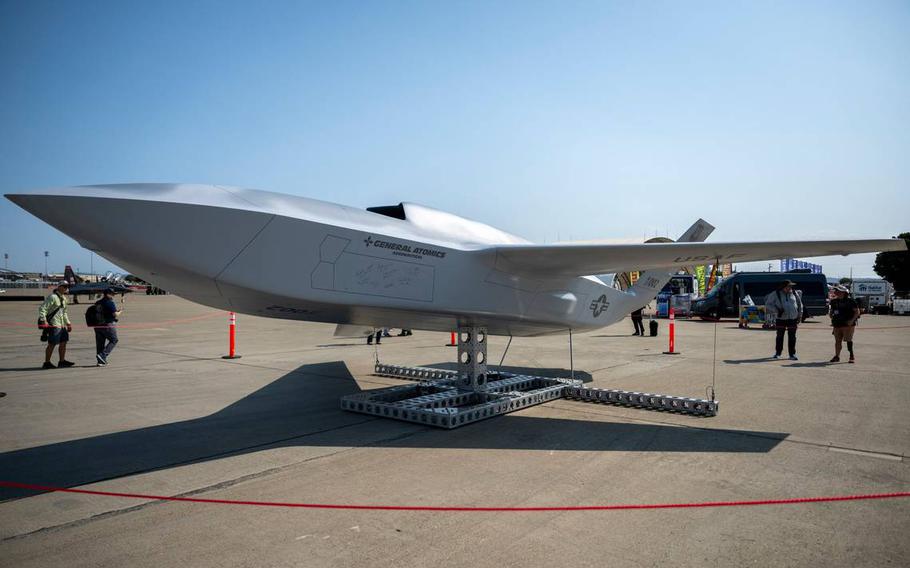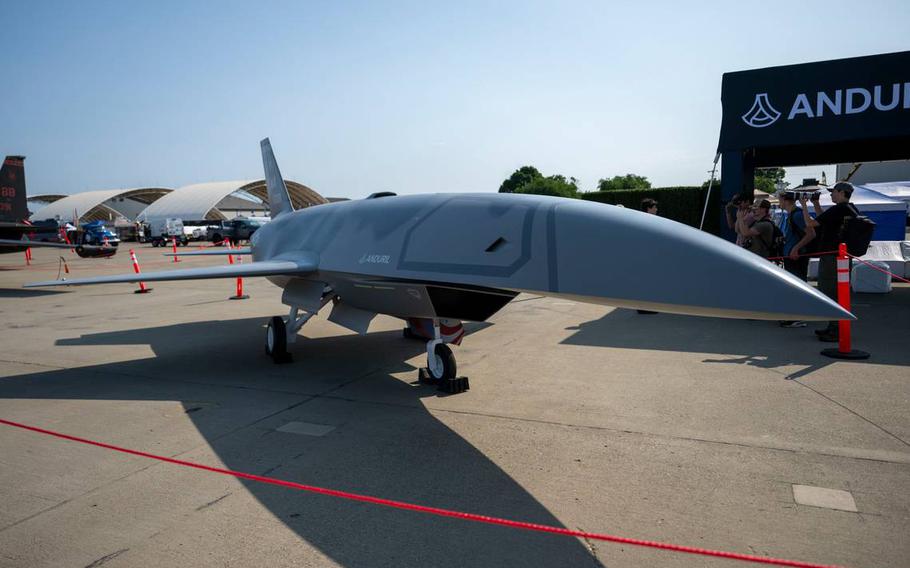
A model of the YFQ42-A collaborative combat aircraft built by defense company General Atomics sits on the apron at Beale Air Force Base on Friday in preparation for the base’s airshow. (Daniel Heuer/The Sacramento Bee via TNS)
SACRAMENTO, Calif. (Tribune News Service) — With a new generation of aircraft comes a shifting focus for Beale Air Force Base, away from its long-held surveillance and intelligence-gathering mission and toward an autonomous combat fleet designed to deploy throughout the world.
The Air Force recently chose the Yuba County, Calif., base to house its “collaborative combat aircraft” program, a newly-developed fleet of mostly autonomous planes meant to accompany fighter jets in the sky. Meanwhile, the U-2 “Dragon Lady” spy plane is slated to retire from Beale in the coming years, although when the high-altitude fleet will officially end its run is unclear.
Air Force pilots have flown U-2 spy planes from Beale for decades, with the aircraft’s phase-out marking a significant change for the reconnaissance base.
“I know there’s a certain sense of sadness as that platform would leave Beale, but I want the community to know that Beale is still incredibly combat relevant and we will be well into the future,” said Col. Keagan “Waldo” McLeese, commander of the 9th Reconnaissance Wing at Beale Air Force Base.
“Our mission set will slowly be changing from more of a reconnaissance-only mindset to more of a power-projection mindset, to where we’re able to create combat effects and deterrence well into the future on our nation’s behalf.”
Models of the YFQ42-A — built by General Atomics — and YFQ-44A — built by Anduril — are on display this Saturday and Sunday at the 2025 Air & Space Expo, the first hosted by Beale in seven years. Air Force officials said this weekend’s event is the first time the futuristic models will appear at an air show for public display.
“It’s really exciting for us to show off what we’re going to be housing and flying around here in the future,” McLeese said.
What are CCA?
The Air Force selected Beale to host its first aircraft readiness unit, which would consist of the new artificial intelligence-driven planes, which differ from other military drones and bring certain advantages of their own.
The planes are designed to flank a fighter jet in the sky, taking commands from the fighter pilot while executing them autonomously. They will fly without a pilot or crew, but will take real-time orders from pilots and Air Force members.

A YFQ-44A collaborative combat aircraft built by defense company Anduril sits on the apron at Beale Air Force Base on Friday in preparation for the base’s airshow. (Daniel Heuer/The Sacramento Bee via TNS)
“That way they don’t go rogue on us,” McLeese said. “We’re able to be very precise about what the mission set is that they’re going to target.”
Each unit is expected to cost $25 million to $30 million, according to past estimates, which is about a third the cost of an F-35 fighter jet. Being more affordable and without a human in the cockpit makes each unit relatively more expendable, adding versatility to how they are deployed in combat situations.
The collaborative combat aircraft program is not expected to last as long as the U-2 spy plane, McLeese said, with the idea being that the Air Force would order a smaller quantity and move on from it more quickly, relative to past fleets, in favor of improved technology in the future.
“The Air Force has a model right now in terms of acquisitions,” McLeese said. “We don’t want to get tied up with these big, massive projects. We want to keep them smaller and that way we can be more dynamic and more agile in the aircraft and platforms we produce so we can create the effects that we desire.”
Although the Air Force chose Beale to host the new program, the aircraft would not likely arrive at Beale before 2027, McLeese said, and its plans may change over time.
Each of the aircraft had been slated for ground testing when Beale was announced as their future home last month, with flight testing expected later this year.
Once on base, Beale would effectively function as a warehouse for the autonomous planes.
“What we do is we serve to keep them in a warm status so they’re ready whenever we need them for combat operations or for deterrence operations,” McLeese said. “We can launch them from here and send them where they need to go, whether that be the Indo-Pacific, or whether that be on the other side of the globe.”
©2025 The Sacramento Bee.
Visit sacbee.com.
Distributed by Tribune Content Agency, LLC.